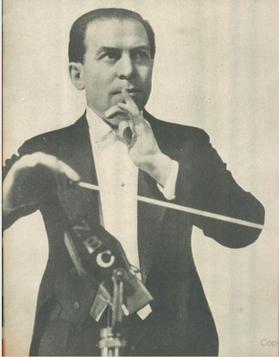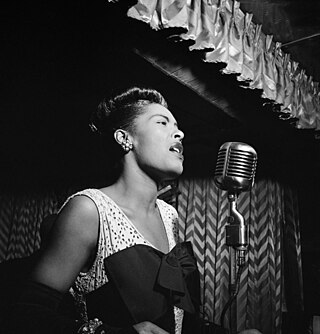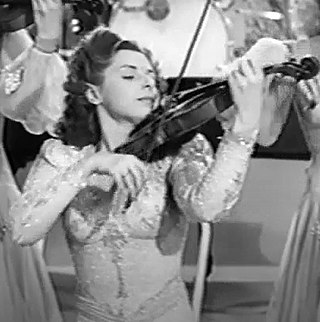
A big band or jazz orchestra is a type of musical ensemble of jazz music that usually consists of ten or more musicians with four sections: saxophones, trumpets, trombones, and a rhythm section. Big bands originated during the early 1910s and dominated jazz in the early 1940s when swing was most popular. The term "big band" is also used to describe a genre of music, although this was not the only style of music played by big bands.

Jan Savitt, known as "The Stokowski of Swing", from having played violin in Leopold Stokowski's orchestra, was an American bandleader, musical arranger, and violinist.

Nicola Joy Nadia Benedetti is an Italian-Scottish classical solo violinist and festival director. Her ability was recognised when she was a child, including the award of BBC Young Musician of the Year when she was 16. She works with orchestras in Europe and America as well as with Alexei Grynyuk, her regular pianist. Since 2012, she has played the Gariel Stradivarius violin. She became the first woman to lead the Edinburgh International Festival when she was made Festival Director on 1 October 2022.

Russell Morgan was an American big band leader and arranger during the 1930s and 1940s. He was best known for being one of the composers of the song "You're Nobody till Somebody Loves You", with Larry Stock and James Cavanaugh, and was the first to record it in 1944.

Mary Alice "Maris" Wrixon was an American film and television actress. She appeared in over 50 films between 1939 and 1951.

Phil Spitalny was a Russian Empire-born American musician, music critic, composer, and bandleader heard often on radio during the 1930s and 1940s. He rose to fame after he led an all-female orchestra, a novelty at the time.

Ina Ray Hutton was an American singer, bandleader, and the elder sister of June Hutton. She led one of the first all-female big bands.

The musical short can be traced back to the earliest days of sound films.

When Johnny Comes Marching Home is a 1942 musical film directed by Charles Lamont and starring Allan Jones and Jane Frazee. The film is loosely based on the song with the same title.
Frances Blaisdell was an American flautist, widely recognized as one of the first female professional flautists. She held positions with the National Orchestral Association, the New Opera Company and the New Friends of Music. In addition, she was the first woman to appear as a soloist and wind player in concert with the New York Philharmonic. In addition to playing, she also held teaching positions at the Manhattan School of Music, New York University, Dalcroze School, Mannes School of Music, and Stanford University where she taught for over 35 years. Blaisdell's teachers included Georges Barrère, Marcel Moyse and William Kincaid.

Women in Music was an American newsletter founded in July 1935 by its publisher and editor, Frédérique Petrides, then the conductor of the Orchestrette Classique – an orchestra based in New York made-up of female musicians. The publication ran until December 1940. The thirty-seven extant issues were reprinted in the 1991 book by Jan Bell Groh, Evening the Score: Women in Music and the Legacy of Frédérique Petrides. The newsletter title Women in Music was coined in 1935 by Petrides's husband, journalist, Peter Petrides to encapsulate the gist of its contents.

Viola Clara Smith was an American drummer best known for her work in orchestras, swing bands, and popular music from the 1920s until 1975. She was one of the first professional female drummers. She played five times on The Ed Sullivan Show, as well as in two films and the Broadway musical Cabaret.
Esther Allan was an American composer, pianist and organist.
There were two independently created and independently operating groups known as the Melodears or Melo-Dears in the 1930s and 1940s, one a band, the other a vocal trio, with similar names only by coincidence. There is no known connection between the two groups.

Women in music include women as composers, songwriters, instrumental performers, singers, conductors, music scholars, music educators, music critics/music journalists, and in other musical professions. Also, it describes music movements, events and genres related to women, women's issues, and feminism.
Women of Rock Oral History Project is an oral history project based at Smith College focusing on American women and gender non-conforming, LGBT, and feminist rock and roll and punk music musicians from the 1970s to the present.
The Hour of Charm is an American old-time radio music program. It debuted on CBS on May 18, 1934, and had its final broadcast on CBS on May 2, 1948. The program also was broadcast on Armed Forces Radio, and after its network broadcasts ended, a new version was syndicated via transcriptions.

Evelyn Kaye Klein (1911–1990) was an American violinist, best known for her performances as "Evelyn and Her Magic Violin" with Phil Spitalny's Hour of Charm Orchestra.

Margherita Maria Francesca LaCentra was an American contralto singer, best known for her work on old-time radio and her singing with Artie Shaw's orchestra. She also performed as Barbara Fulton.

Katharine Kemp Stillings was a violinist, composer, and music educator.
















